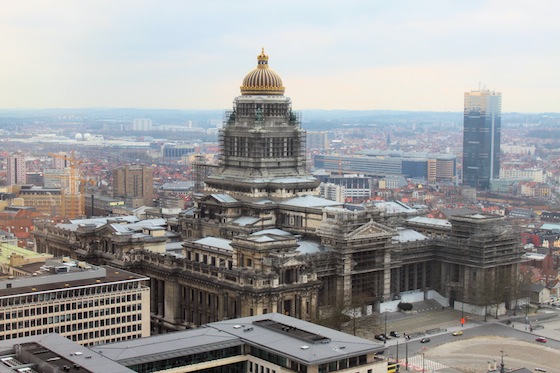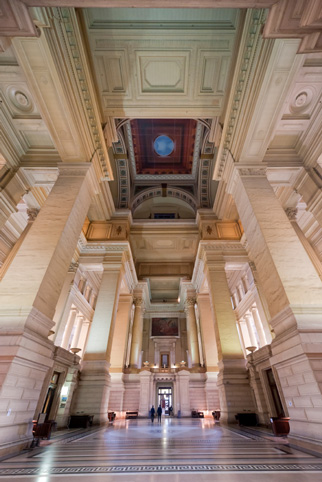It was love at first sight. The pure eyed beauty is justice. Her admirer is architect Joseph Poelaert. His love for the beauty was so great that he built an immense palace for her. In reality it’s a monster. As the expression goes, it’s the thought that counts.
We will never really know what the architect was thinking at the time. Driven by his project, he died suddenly of a stroke, four years before the inaugural ceremony.
Today, Belgians have a palace of justice that is sometimes called the behemoth. It’s the colossal size of the building that makes tourists stop and ponder, not its esthetics. The interior is so vast that it’s said that dozens of rooms are empty. The doors have been closed for a long time.
The palace of justice is still incomplete, but the behemoth is still alive. Each day, hundreds of lawyers and employees pass through its doors to preserve the pureness of justice. And that doesn’t include visitors.

What happened?
It’s the mid-1800s. A small country is born: Belgium. The capital is Brussels. To give the new country an impression of size and to show its desire to consecrate the independence of judges and lawyers versus politics, King Léopold I ordered the construction of a palace of justice using architecture that would make Belgians proud.
Joseph Poelaert gets the contract. He is known for exceeding initial costs. He also likes mass effects. He would not deprive himself.
Construction began in 1866. Since there was no end in sight, King Léopold II went ahead with the official inauguration in 1883, four years after the death of Poelaert. Needless to say, the initial budget was greatly surpassed.
The Brussels palace of justice is bigger than Saint Peter’s Basilica in Rome. A fifteen-metre house would easily fit through the entrance. The building is still the world’s biggest palace of justice with its hundreds of rooms, eight interior courts, its dome rising 100 metres above the general assembly building lobby which is said to be incredibly big.

The interior is a labyrinth of giant vestibules, staircases, corridors, vaults, columns, cornices and statues dedicated to justice. It’s like entering another world. Orson Welles was so stricken by the interior maze that he wanted to shoot his famous movie The Trial. The request was turned down.
Poelaert tried to blend several styles in his creative momentum: gothic, neoclassic, Greco-Roman, Egyptian. Apparently it’s quite confusing. It’s impossible to define the building’s style. This didn’t prevent creators in Peru from copying Poelaert’s work to build the palace of justice in Lima, the capital. On a smaller scale of course.
To make room for the monster, land had to be expropriated at the time. According to legend, the area’s inhabitants were so furious that they used the words schieven architek (twisted architect) to insult someone. These words are still heard today.
Ironically, the palace of justice was built on the hill where criminals used to be executed. The bodies were then exposed in the famous Grand Place of Brussels, which has become the most beautiful garden in Europe in the eyes of many people.
References:
French Wikipedia article Le palais de justice de Bruxelles
French Wikipedia article on Joseph Poelaert
Bruxelles, Le routard, Hachette, 2013, 239 pages
Beauté de la Belgique, text by Noël Graveline, Minerva, 1997, 140
pages
Bruxelles à petits prix, cheap and chic, 2012, 198 pages
Photos:
Exterior of the Brussels Palace of Justice: Wikipedia Creative Commons Attribution-Share Alike Martin Mycielski (Stansfield)
Interior of the Brussels Palace of Justice: iStockphoto LP
